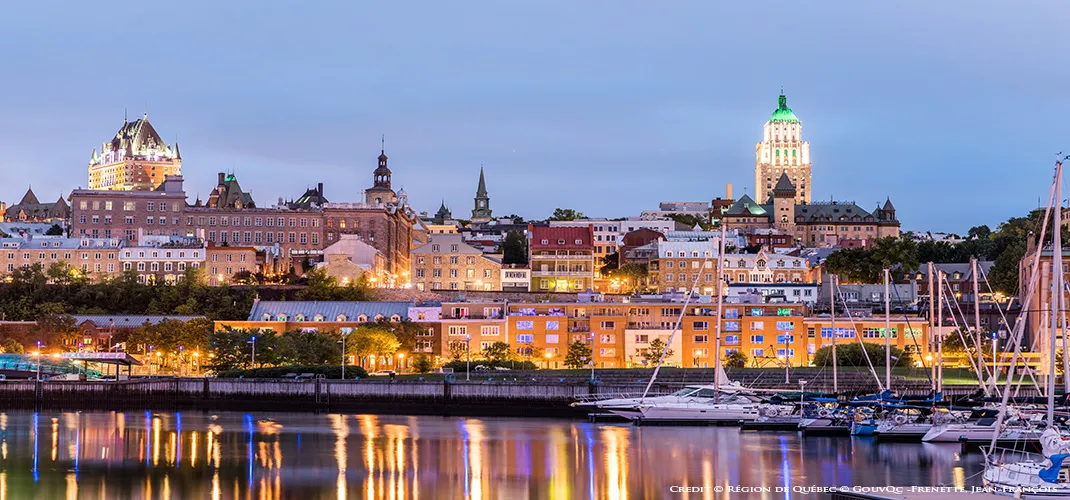Québec City

Québec City is the only Walled City in North America and is also UNESCO World Heritage Site. The French speaking Québec City has a strategic location at the top of steep cliffs overlooking the St. Lawrence River. Founded in 1608 as a fur trading colony, today the Place Royale has become an administrative centre and now the Capital of Québec Province and one of the most beautiful cities in Canada.
The Upper Town, also known as Haute-Village, was originally developed for its military advantage and contains the defensive Citadel, as well as some of the city's most iconic landmarks including the Château Frontenac and City Fortifications.
The Lower Town or Basse-Ville is where the original settlement was located and is recognised for its picturesque, narrow streets and historic stone buildings. This is where you will find the Place Royale and the Quartier Petit Champlain. There are stairs and a number of steep streets that lead down from the Upper Town to the Lower Town, making the entire area easy to explore on foot. When you reach the bottom you will arrive at the St. Lawrence River, making for a really picturesque background.
Place Royal is the tourist hub of Québec with restaurants, patios and shops that now fill the historic structures. Named in honour of Louis XIV whose bust adorns it, Place Royale is the largest surviving ensemble of 17th and 18th Century buildings. The pretty stone Church, Notre-Dame des Victoires faces a cobbled stone square, along with Maison Chevalier of the Musée de la Civilisation. Adjacent to Place Royale, facing out over the river and encircled by stout walls and palisades, the little 1691 Batterie Royale was constructed.
The Quartier Petit Champlain is arguably one of the most beautiful areas of the city with narrow streets that move between the historic buildings. The stone structures that line the pedestrian only streets now house a wide variety of shops and restaurants and artisan boutiques.
Château Frontenac was constructed for the Canadian Pacific Railway in 1894, the Grand Fairmont Le Château Frontenac is now one of the city's most prominent landmarks and esteemed hotels. This historic property can be seen from kilometres away and is especially impressive at night. In front of the hotel, Terrasse Dufferin offers stunning views northwards to the Laurentians and the Promenade des Gouverneur’s leads southwards toward the Citadel and Plains of Abraham. This elevated vantage was the original site of Fort St. Louis, the Governor's residence in colonial times. Tourists can see the ruins underneath the promenade.
Soaring upwards from the west and facing the St. Lawrence River, Cap Diamant at a height of 100 metres has a stunning view. Sitting at the top is Québec's star shaped La Citadelle de Québec, a massive Fortress protected by thick walls, ramparts and ditches that were built in 1832. Still an active military post, the Citadel is used as military quarters for Generals, Officers and Servicemen, as well as the summer residence for the Governor General of Canada. In summer, visitors can watch the Changing of the Guard Ceremony each morning and the Military Museum, located in the mid-18th Century Powder Magazine is open all year round.
Sainte-Anne is the Patron Saint of Québec and is credited with many miracles of healing the sick and disabled. Located northeast of Québec in Beaupré, you will find the beautiful Basilica of Sainte-Anne-de-Beaupré where countless pilgrims visit every year. Another famous Catholic Basilica in Québec is the Cathedrale Notre-Dame-de-Québec, completed in 1844. The interior of Notre-Dame de Québec is very impressive with a beautiful altar, episcopal canopy and stained glass windows.
Other places you should also visit while here in Québec include the Musée de la Civilisation, a three part institution that delves into the many facets of human history and the establishment of French America, with the main museum located in Basse-Ville near the Old Port. Built to designs by the well-known architect Moshe Safdie, the central museum is of great architectural interest. The permanent collection draws from civilisations all over the world, as well as exploring the Québec experience. The Musée de l'Amérique Francophone ‘Museum of French America’ is housed in the historic Séminaire de Québec in Upper Town.
The Parliament Building ‘Hôtel du Parlement’ and Parliament Hill is spaciously laid out near the Old Upper Town. Completed in 1877, the Salle de l'Assemblée Nationale ‘National Assembly’ and Salle du Conseil Législatif ‘Legislative Council’ are both open to the public. Nearby, you will also find the Grand Théâtre as well as the large Palais des Congrès shopping and entertainment complex. Beyond the City Walls, Grande Allée forms the spine of the city. The district near Parliament Hill is of greatest interest to tourists. Here, a bevy of restaurants, patios and entertainment venues bring many visitors. The street's grandiose 19th Century buildings were once home to the city's upper class. Other attractions on the Grande Allée include the Grande Allée Drill Hall, Battlefields Park and the Musée National des Beaux-Arts du Québec.
The Québec-Levis Ferry provides a great service between Québec City and Levis, just across the St. Lawrence River. This quick crossing is also an inexpensive way to do some sightseeing to see the magnificent views of the city skyline. At sunset, you can see lights illuminate the Château Frontenac, the Price Building and other historic structures.
